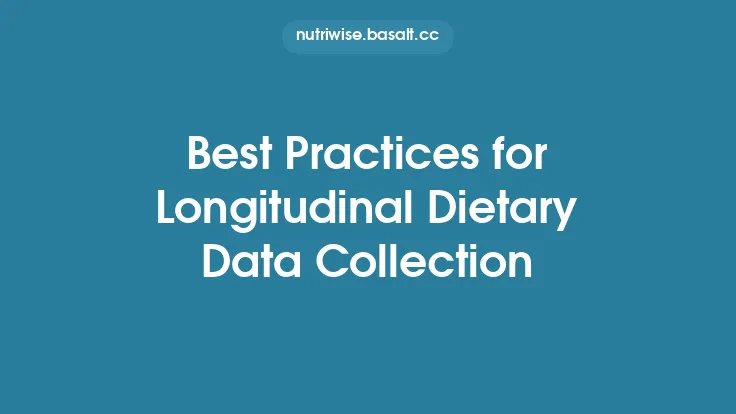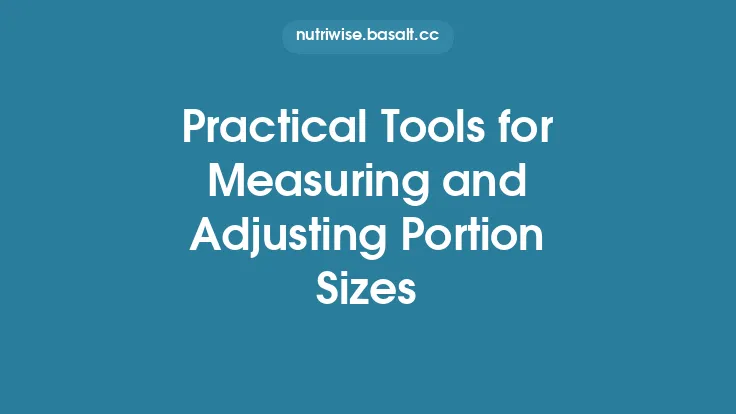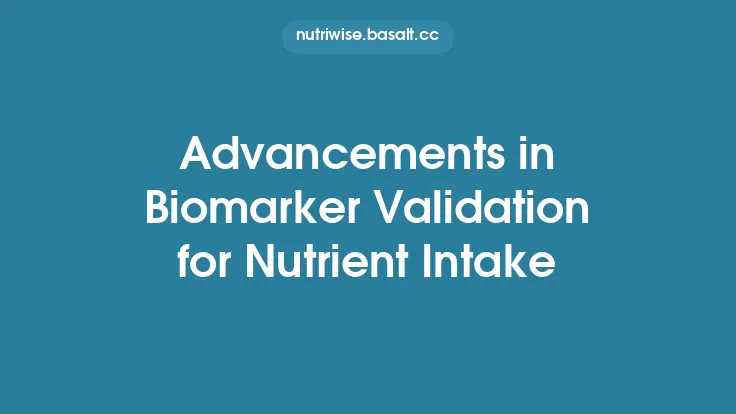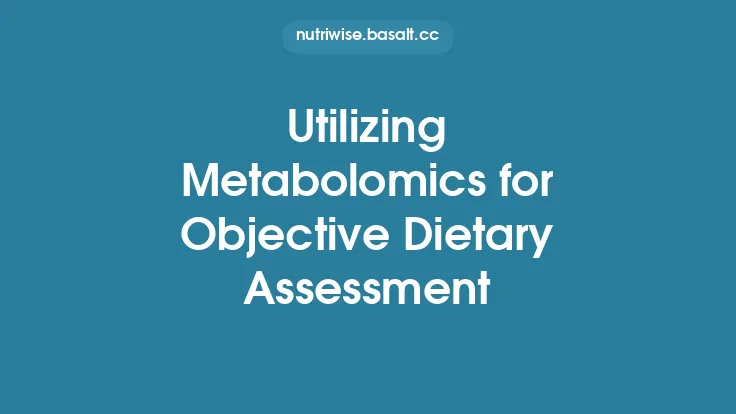Accurate nutrient tracking has long been a cornerstone of nutrition research, yet traditional methods such as paper‑based food records, 24‑hour recalls, and food frequency questionnaires (FFQs) often suffer from recall bias, under‑reporting, and labor‑intensive data entry. Over the past decade, a wave of innovative dietary assessment tools has emerged, leveraging advances in mobile computing, image processing, natural language processing, and cloud‑based data integration. These tools aim to reduce participant burden, improve precision, and generate richer datasets that can be seamlessly linked to other health information. The following sections explore the most promising technologies, their methodological underpinnings, validation strategies, and practical considerations for researchers seeking to adopt them in nutrition studies.
1. Image‑Based Dietary Assessment
1.1. Smartphone Photo Capture and Portion Estimation
Modern smartphones are equipped with high‑resolution cameras and powerful processors, making them ideal platforms for capturing meals in real time. Participants simply photograph their food before and after consumption, and the images are uploaded to a secure server. Automated portion estimation algorithms then analyze the images to infer volume and weight.
Key technical components include:
- Reference Object Scaling: Users place a known object (e.g., a standard-sized card or a fiducial marker) in the frame to provide a scale for size estimation.
- Depth Sensing: Devices with dual‑camera or LiDAR sensors can generate depth maps, allowing three‑dimensional reconstruction of food items for more accurate volume calculations.
- Segmentation and Classification: Convolutional neural networks (CNNs) segment the image into distinct food items and classify them against a curated food image database.
- Nutrient Mapping: Once the food type and portion size are identified, the system queries a nutrient composition database (e.g., USDA FoodData Central) to compute macro‑ and micronutrient content.
1.2. Validation and Accuracy
Validation studies typically compare image‑derived nutrient estimates against weighed food records, the gold standard for portion measurement. Reported mean absolute errors for energy intake range from 10–15 % when using depth‑enhanced imaging, with lower errors for macronutrients (protein, fat, carbohydrate) than for micronutrients that depend on cooking methods and ingredient variability. Ongoing research focuses on improving classification of mixed dishes and culturally specific foods by expanding training datasets.
1.3. Practical Implementation
- User Training: Brief instructional videos and in‑app prompts improve compliance and image quality.
- Data Privacy: End‑to‑end encryption and anonymization of images are essential to meet ethical standards.
- Scalability: Cloud‑based processing pipelines can handle thousands of images per day, making the approach suitable for large cohort studies.
2. Barcode and QR‑Code Scanning
2.1. Automated Food Item Identification
Packaged foods carry universal product codes (UPCs) or QR codes that encode product identifiers. Mobile apps equipped with barcode scanners allow participants to log packaged items instantly. The scanned code is matched to a product database that contains detailed nutrient profiles, including serving size, ingredient list, and fortification information.
2.2. Database Integration
- Commercial Databases: Companies such as Nutritionix and Open Food Facts maintain extensive, regularly updated product catalogs.
- Custom Databases: Researchers can upload institution‑specific product lists (e.g., school cafeteria menus) to ensure coverage of locally relevant items.
- Dynamic Updates: APIs enable real‑time retrieval of the latest nutrient information, accounting for reformulations and new product launches.
2.3. Strengths and Limitations
Barcode scanning eliminates the need for manual entry and reduces misclassification of packaged foods. However, it does not capture unprocessed or home‑cooked meals, which remain a substantial portion of many diets. Combining barcode scanning with other tools (e.g., image capture) can provide comprehensive coverage.
3. Voice‑Activated Dietary Logging
3.1. Natural Language Processing (NLP) for Food Description
Voice assistants (e.g., Amazon Alexa, Google Assistant) can be programmed to accept spoken dietary entries. Users simply state what they ate, and the system parses the utterance using NLP pipelines:
- Speech‑to‑Text Conversion: High‑accuracy speech recognition models transcribe spoken input.
- Entity Extraction: Named‑entity recognition identifies food items, portion descriptors (e.g., “a cup,” “two slices”), and preparation methods.
- Contextual Disambiguation: Language models resolve ambiguities (e.g., “biscuit” vs. “scone”) based on user‑specific dietary patterns or regional vocabularies.
3.2. Integration with Nutrient Databases
After extraction, the identified foods are matched to a nutrient database, and portion sizes are converted to gram equivalents using standard conversion factors. The resulting nutrient profile is stored in the participant’s longitudinal record.
3.3. Advantages for Specific Populations
Voice logging is particularly valuable for:
- Older adults who may have limited dexterity for typing.
- Individuals with visual impairments.
- Populations with low literacy, as spoken input bypasses the need for reading or writing.
3.4. Validation Considerations
Studies comparing voice‑logged entries to weighed records report comparable accuracy to traditional self‑administered 24‑hour recalls, provided that the speech recognition engine is trained on the target language and dialect. Continuous improvement of language models is essential to maintain high precision.
4. Smart Kitchenware and Sensor‑Embedded Utensils
4.1. Weight‑Sensitive Plates and Bowls
Electronic plates equipped with load cells can measure the weight of food before and after a meal. The device transmits weight data via Bluetooth to a companion app, which timestamps each measurement and links it to the participant’s profile.
4.2. Temperature and Moisture Sensors
Some smart utensils incorporate temperature probes and moisture sensors to infer cooking methods (e.g., boiling vs. grilling) and water loss, which affect nutrient density. By capturing these parameters, the system can adjust nutrient calculations more accurately than static databases.
4.3. Data Fusion
When combined with image capture or barcode scanning, sensor data provides a multi‑modal view of intake:
- Weight data refines portion estimates derived from images.
- Temperature readings inform the selection of appropriate cooking factor adjustments in nutrient databases.
4.4. Implementation Challenges
- Cost: High‑precision load cells and wireless modules increase device price, limiting large‑scale deployment.
- User Acceptance: Participants may be reluctant to replace familiar dishes with instrumented versions. Pilot testing and ergonomic design are crucial for adoption.
5. Integrated Mobile Platforms for Real‑Time Feedback
5.1. Closed‑Loop Nutrient Monitoring
Modern dietary apps can deliver instantaneous feedback on nutrient intake relative to personalized goals. By aggregating data from images, barcodes, voice entries, and smart kitchenware, the platform computes cumulative nutrient totals throughout the day.
5.2. Adaptive Goal Setting
Machine‑learning algorithms (distinct from pattern‑decoding models) can adjust recommended intakes based on user behavior, health status, and dietary preferences. For example, if a participant consistently exceeds sodium targets, the app can suggest lower‑sodium alternatives in real time.
5.3. Behavioral Nudges
Push notifications, visual dashboards, and gamified elements (e.g., streaks, achievement badges) encourage consistent logging and promote healthier choices. Evidence suggests that real‑time feedback improves adherence to dietary interventions compared with delayed reporting.
6. Methodological Considerations for Researchers
6.1. Selecting the Appropriate Toolset
- Study Population: Younger, tech‑savvy cohorts may favor image‑based methods, whereas older adults might benefit from voice logging.
- Dietary Complexity: Populations with high consumption of mixed dishes may require a hybrid approach (image + manual entry).
- Resource Constraints: Barcode scanning is low‑cost and easy to implement, while smart kitchenware demands higher upfront investment.
6.2. Validation Protocols
Researchers should conduct validation studies that:
- Compare against weighed food records for a subsample of participants.
- Assess inter‑method reliability (e.g., image vs. barcode vs. voice).
- Evaluate usability through qualitative interviews and compliance metrics.
6.3. Data Management and Standardization
- Metadata Capture: Record device type, software version, and timestamp for each entry to facilitate reproducibility.
- Nutrient Database Versioning: Document the exact version of the nutrient composition database used, as updates can alter nutrient values.
- Secure Storage: Employ encrypted databases and comply with relevant data protection regulations (e.g., GDPR, HIPAA).
6.4. Ethical and Privacy Issues
- Informed Consent: Clearly explain what data (including images and voice recordings) will be collected and how it will be used.
- Anonymization: Strip identifying information from images (e.g., faces, location metadata) before analysis.
- Data Retention Policies: Define retention periods and procedures for data deletion upon participant request.
7. Future Directions
7.1. Multi‑Modal Fusion with Wearable Sensors (Non‑Invasive)
While the focus of this article excludes wearable technology, emerging research is exploring the integration of non‑invasive physiological sensors (e.g., continuous glucose monitors) with dietary logging to provide indirect validation of nutrient intake. Such fusion could enhance the reliability of self‑reported data without relying on invasive biomarker collection.
7.2. Community‑Driven Food Image Libraries
Open, crowdsourced repositories of annotated food images can improve the generalizability of image‑recognition models across cultures and cuisines. Collaborative platforms that allow researchers to contribute and curate images will accelerate model training and reduce bias.
7.3. Real‑World Implementation in Clinical Settings
Embedding these tools within electronic health record (EHR) systems can streamline dietary assessment during routine clinical visits. Automated extraction of nutrient data from patient‑entered apps could inform personalized nutrition counseling and monitor adherence to therapeutic diets.
7.4. Regulatory Standards for Digital Dietary Tools
As digital assessment tools become more prevalent, establishing consensus standards for accuracy, validation, and data security will be essential. Professional societies are beginning to draft guidelines that will help researchers select and report on digital methods consistently.
8. Conclusion
Innovative dietary assessment tools—ranging from image‑based portion estimation and barcode scanning to voice‑activated logging and sensor‑enhanced kitchenware—are reshaping how nutrition researchers capture nutrient intake. By reducing reliance on memory, minimizing participant burden, and providing richer, real‑time data, these technologies enable more precise quantification of dietary exposures. Successful implementation hinges on careful selection of methods aligned with study objectives, rigorous validation against gold‑standard measures, and robust data governance practices. As the field continues to evolve, the integration of multi‑modal digital tools promises to deliver ever‑more accurate, scalable, and user‑friendly solutions for nutrient tracking, ultimately strengthening the evidence base that underpins nutrition science.





